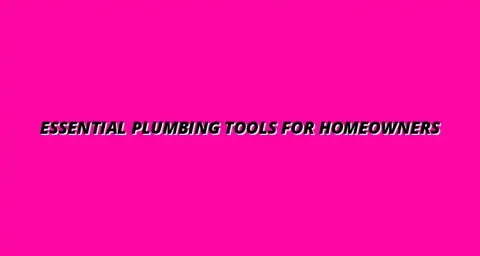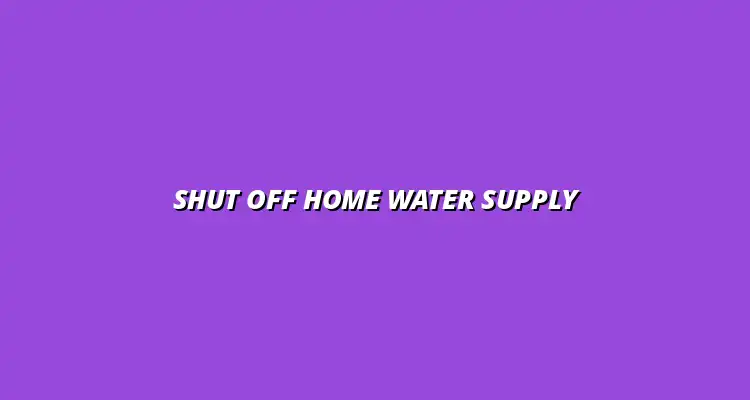
- Plumbing Basics
- Jan 06
2025-01-22
Shutting off your home's water supply is one of the most important steps you can take to protect your property and ensure safety during a plumbing emergency. Water is vital for daily living, but when it leaks or floods, it can cause significant damage. Understanding when and why to shut off your water supply can save you from costly repairs and unwanted stress.
Knowing how to turn off your water supply also empowers you as a homeowner. It gives you control over potential plumbing disasters and allows for quicker responses to emergencies. Whether it's a burst pipe or an overflowing toilet, being prepared makes all the difference! For example, knowing how to fixing a running toilet easily can save you from significant water waste and potential damage.
Your home's water supply is crucial for both comfort and safety. It provides water for drinking, cleaning, bathing, and more. However, when that water supply malfunctions, it can lead to serious issues like flooding, mold growth, and structural damage.
By understanding the role of your water supply, you can mitigate these risks. Regular maintenance and knowing how to quickly shut off the water can help you tackle emergencies effectively. Always be aware of how water supply issues can affect your household safety! Understanding water pressure in plumbing is a crucial first step.
Various situations may require you to shut off your water supply immediately. Recognizing these emergencies can help you act swiftly. Here are some common scenarios:
When faced with these emergencies, knowing how to turn off your water supply can prevent further damage. Being prepared ensures that you can handle these situations confidently and effectively!
To manage your home’s water supply effectively, it’s essential to understand its components. This knowledge helps you identify potential problem areas and facilitate prompt action during emergencies. Let’s explore the main elements of a typical home plumbing system.
Every home's plumbing system includes pipes, fixtures, and valves that work together to deliver water where it is needed. Understanding how these parts interact can enhance your ability to respond effectively to water supply issues. Low water pressure? Check out this guide on fixing low kitchen water pressure.
Your home's plumbing system is a complex network that ensures you have access to clean water. This system includes supply lines, drainage systems, and fixtures. Each component plays a significant role in maintaining water flow and hygiene throughout your home.
Having a basic understanding of these components can help you identify issues faster. If something goes wrong, knowing the layout of your plumbing can save precious time in an emergency!
The main water shut-off valve is a critical part of your plumbing system. Knowing where it is located allows you to act quickly in emergencies. If you ever need to turn off the water supply, this valve is your go-to solution!
Locating this valve ahead of time can alleviate panic during an emergency. Make sure all household members know its location so that everyone can respond quickly if needed!
Understanding where to find your main shut-off valve is essential. Here are some typical locations you might check:
Knowing these locations can help you quickly address any plumbing issues that may arise. It’s a good idea to inspect these areas regularly to ensure you can easily reach the valve. Winterizing your pipes is also important; check out these winter plumbing preparation tips.
There are different types of shut-off valves, each serving the same purpose but functioning differently. Two common types are ball valves and gate valves. Understanding their distinctions can help you operate them effectively.
Being familiar with these types can make it easier when turning off your water supply. Choose the right approach based on the valve you have at home to ensure you can respond quickly and effectively!
Managing your home’s water supply is essential for preventing damage and ensuring safety. By following some best practices, you can keep your plumbing systems functioning properly. These practices will help you stay ahead of potential problems and provide peace of mind when it comes to your home maintenance.
One of the key aspects of effective water supply management is regular maintenance. This not only extends the life of your plumbing but also helps you catch issues before they become major problems. Let’s look at some actionable steps you can take today! If you need a plumber, you can search for one near you using a tool like this plumber search.
Regular maintenance is vital to keeping your plumbing system in top shape! It’s important to inspect and perform small repairs regularly. Here are some suggestions to help you maintain your plumbing:
By staying on top of these maintenance tasks, you can spot problems early and save money in the long run. Don't forget to keep records of your inspections and repairs for future reference!
Having an emergency response plan can make a big difference when a plumbing crisis occurs. Knowing what steps to take can minimize damage and stress. Here’s how you can create this plan:
By preparing in advance, you can act quickly and efficiently during any plumbing emergency. This proactive approach can significantly reduce the risk of severe water damage!
When faced with a water emergency, having the right resources can prove invaluable. There are many tools and professional services available to assist homeowners in times of need. Knowing where to find help can make a tough situation more manageable.
In addition to having your emergency plan in place, it’s wise to familiarize yourself with local resources. This way, you won't be scrambling to find help when you need it most. Let’s explore some key resources you can rely on!
When a plumbing issue arises, finding a qualified plumber fast is crucial. Here are some tips for locating reliable plumbing services:
Remember, it’s better to have a go-to plumber before an emergency strikes. Doing your research now can save you time and frustration later!
An emergency preparedness kit is an essential resource for any homeowner. It should include tools and supplies that can help you handle minor plumbing issues. Here are a few must-have items to consider:
Having these tools readily available can make a significant difference when trouble arises. Being prepared is always better than reacting in the moment!
Preparedness is key when it comes to effective home water management. By being proactive, you can protect your home and save yourself from costly repairs. Understanding the importance of preparation empowers you to take control of your home maintenance.
Taking the time to educate yourself about plumbing systems and potential issues is an investment in your home’s safety. With the right knowledge, you can navigate challenges with confidence and efficiency!
Knowledge is power when dealing with plumbing and water systems. By learning about your home’s water supply, you can make informed decisions and feel more in control. Here are some ways to empower yourself:
By gathering information and connecting with others, you can build a solid foundation of knowledge for managing your home’s water supply!
Home maintenance is not a one-time task; it’s an ongoing journey. Encouraging continuous learning about plumbing and water systems can save you time and money. Here are a few tips to keep your education going:
With a commitment to ongoing education, you can stay ahead of plumbing issues and confidently manage your home’s water supply. Let’s keep our homes safe and sound together!
